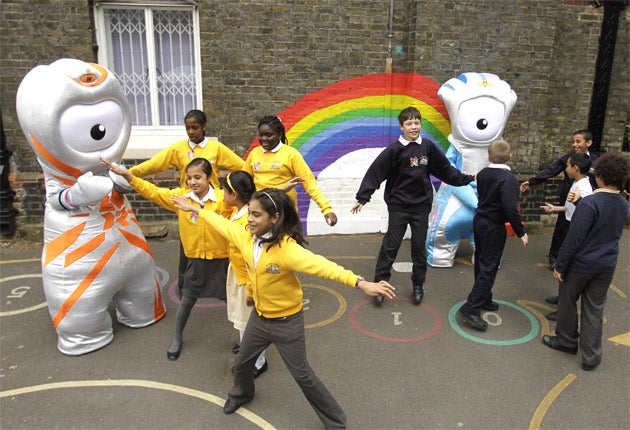Ian Burrell: London's new Olympic heroes - don't sneer...

"Why have we produced a mascot?" asked Lord Coe of the rows of children sat cross-legged before him on the parquet floor of a Victorian school gymnasium, in the East End of London, yesterday afternoon.
It was a reasonable question, given the howls of outrage that followed the unveiling of the £400,000 London 2012 logo three years ago. And although he looked every inch the school games teacher, the double Olympic gold medallist thought it best to field that tricky one himself. "The real answer," he told the kids, "is that we have made the mascots for you because we want them to be a friend."
Then he unveiled a moving animation, introducing us to the two mascots Wenlock and Mandeville. It showed that the London Olympics organisers learnt a few of their own lessons from the fiasco of 2007. The logo created by design firm Wolff Olins neither charmed kids (save for a vague resemblance to Lisa Simpson) nor the design community.
London 2012's film is based on a specially-written story by the former children's laureate Michael Morpurgo. It had echoes of The Wizard of Oz and Pinocchio's Giuseppe, telling a tale of a stubble-chinned steelworker called George who'd helped build the Olympic stadium and been given a couple of chunks of metal from the final girder as a retirement present.
Some might have preferred a gold watch but not George, who went home to his semi and, in his garden shed, recycled the steel lumps into two toys which, after being presented to his grandchildren, burst into life and began pirouetting around the room like Olga Korbut.
Then they disappeared beyond the London skyline and over the rainbow (no, really) as the voiceover predicted: "They will meet again... in London... 2012. They will be there. You will be there. The whole world will be there." Park your cynicism, because the kids loved it. But not as much as when they saw the real Wenlock and Mandeville, unveiled by two of their 11-year-old classmates, Dean Marshall and Tanya Hossain. "Oooh," came the cry from the gym of St Paul's, Whitechapel.
Mandeville looks like a svelte Sonic the Hedgehog with a blue colouring and spiky mane. Wenlock has gold markings and friendship bands around its wrists to signify the Olympic rings. Both have lights on their heads inspired by London taxis. They are gender-neutral and each has a single eyeball, a camera to photograph people they meet as they promote the Olympics.
Why Wenlock and Mandeville? They are symbols of Britain's Olympic roots. In 1890 the modern Olympics founder Baron Pierre de Coubertin visited the Shropshire village of Much Wenlock and was inspired by local doctor William Penny Brookes, whose admiration for the ancient Greeks had moved him to establish the Wenlock Games. Stoke Mandeville is where the Paralympic movement was founded by the neurosurgeon Sir Ludwig Guttman.
London's Conservative mayor Boris Johnson described the blue and gold mascots as a "solid coalition that will capture our imagination". Designers may yet sneer, though journalists were struggling: "It's quite hard to take the piss out of," moaned one.
Mandeville and Wenlock will be a success if children follow them to the 2012 website and into a love of sport. Yesterday Lord Coe was urging the class into cyberspace: "If you want to make friends with them, go online. Start talking to them and find out about the sports you can do."
Join our commenting forum
Join thought-provoking conversations, follow other Independent readers and see their replies
Comments